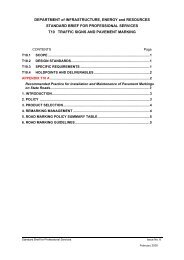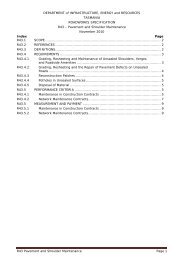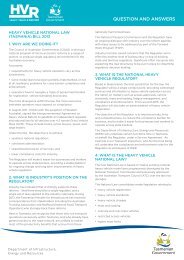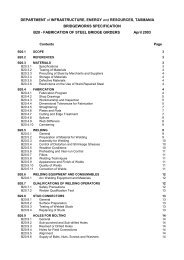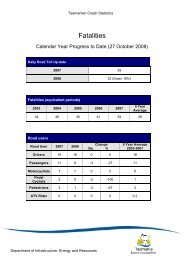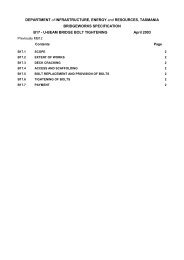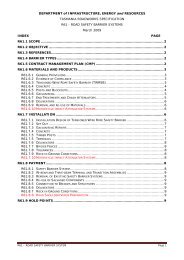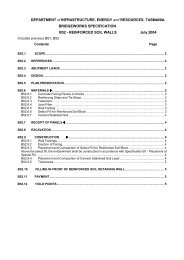Public Environment Report Tarkine Forest Drive ... - Transport
Public Environment Report Tarkine Forest Drive ... - Transport
Public Environment Report Tarkine Forest Drive ... - Transport
- No tags were found...
You also want an ePaper? Increase the reach of your titles
YUMPU automatically turns print PDFs into web optimized ePapers that Google loves.
There have been no records of this species from the section of road impacted by theproposed action. With such a conspicuous flower it is unlikely to have been overlooked,given the intensity of surveys in this area during the peak flowering period (NBES2011).4.10.3 Leafy Greenhood (Pterostylis cucullata subsp. cucullata)AbundanceThe estimated total population of leafy greenhood in Tasmania is 10,000 to 11,000plants (Threatened Species Section 2010a). The Australian population is estimated toinclude 50,000 Duncan (2010). There are sixteen subpopulations in Tasmania. Locally,there are two populations at Gardiner Point near Arthur River (23 plants) and PossumBanks south of Temma (2000-3000) (Threatened Species Section 2010a).Distribution, ecology and habitat preferenceIn Tasmania this robust terrestrial orchid species is known only from the coast from thefar north west including offshore islands and from one population on Flinders Island oncalcarenite soils (Figure 4.6). The habitat in northwest Tasmania is tea-tree orpaperbark scrub on stabilised dunes in well drained locations. On Flinders Island it is onthe edge of a vegetation change between Flinders island scrub and tussock grassland.The niche is sheltered south to south east facing sites protected from prevailing windsand in seasonally damp soils. It has a linear range of 350 km and an area of occupancyof 80 ha (Threatened Species Section 2010a).Habitat occurs in the vicinity of Segment A. There are no observation records shown inAppendix A, although there is a record at Gardiner Point just off Map 1.The potential flowering period for this species is October to November with a peak inlate October to early November (Wapstra et al. 2010).Known threatsThe key threats to leafy greenhood include land clearance, cattle grazing andinappropriate fire regimes. In summary, the threats to the species include thefollowing (Threatened Species Section 2010b):Habitat loss (dune destabilisation, marram grass planting and spread, agriculturaland urban development)Cattle grazing (trampling, nutrient enrichment)Inappropriate fire regimes (reduced burning could lead to scrub invasion modifyinghabitat)Predation (browsing by garden snails)Weeds (pasture grasses)Climate change (unknown influence, possible changes to rainfall)Stochastic risks.No threats to this species will be derived from this action. No habitat is in the vicinity.No changes to cattle grazing are anticipated. No expectation for reduction in fireregime resulting from this action. No likelihood of garden snails being introduced tosites, not least because the works are not anticipated to occur in the vicinity of knownhabitat and no plant material is proposed to be transported. Likewise, there is nosignificant likelihood of weeds being introduced to known habitat as the action isspatially removed (>1 km) from habitat. The action will have no impact on climatechange.Ref: HB09080H001 PER <strong>Tarkine</strong> <strong>Drive</strong> 33P Rev 00/DL/CL/jw 54



